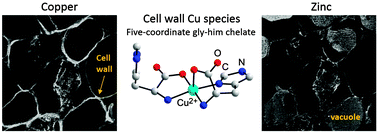Thlaspi arvense binds Cu(ii) as a bis-(l-histidinato) complex on root cell walls in an urban ecosystem†
Abstract
Root cell walls accumulate metal cations both during acquisition from the environment and removal from the protoplast to avoid toxicity, but molecular forms of the metals under field conditions remain elusive. We have identified how copper is bound to cell walls of intact roots of native Thlaspi arvense by combining synchrotron X-ray fluorescence and absorption techniques (XANES and EXAFS) at the nano-, micro-, and bulk scales. The plants grew naturally in sediment in a stormwater runoff basin at copper concentrations typical of urban ecosystems. About 90% of acquired copper is bound in vivo to cell walls as a unique five-coordinate Cu(II)–bis(L-histidinato) complex with one L-histidine behaving as a tridentate ligand (histamine-like chelate) and the other as a bidentate ligand (glycine-like chelate). Tridentate binding of Cu(II) would provide thermodynamic stability to protect cells against copper toxicity, and bidentate binding may enable kinetic lability along the cell wall through protein–protein docking with the non-bonded imidazole group of histidine residues. EXAFS spectra are provided as ESI to facilitate further identification of Cu–histidine and distinction of Cu–N from Cu–O bonds in biomolecules.


 Please wait while we load your content...
Please wait while we load your content...